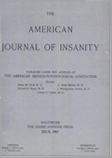Abstract
(1) There must be in the minds of medical men a sharp differentiation between the psychosis involutional melancholia and the benign "menopausal symptoms" common to both females and males at the climacteric.
(2) The endocrine factors incident to change of life are not the important etiological or precipitating factors in the psychosis. In only 24 per cent of 53 women did there seem to be any relationship between the onset of menopause and the onset of the psychosis.
(3) Life long restrictions of the personality and traits deeply rooted in the psychobiology of the individual are more significant than physiological factors in the etiology of involutional melancholia. The psychosis appears to be the culmination of many forces operating throughout the life history of the patient.
(4) Metrazol therapy, which in nearly 73 per cent brings about favorable change classifiable as "recovery" or as "social remission," is the most successful treatment thus far developed. Unmodified metrazol therapy with its serious hazards probably cannot continue as a standard method. Because of the poor prognosis in involutional melancholia (30 per cent in 300 cases at the Pennsylvania Hospital) some form of convulsive shock therapy seems justifiable, especially if the newer modifications of metrazol treatment or electric shock prove helpful in reducing the traumatic risk without interfering with the effectiveness of the treatment. Although brilliant recoveries are occasionally recorded in long standing cases of involutional melancholia, our results indicate that promptness is an important factor in the success of treatment.
(5) Prolonged narcosis has been helpful in a small number of cases and has given rise to no serious complications. It should be tested further in a larger number of cases.
(6) Estrogenic therapy in female involutional melancholia patients has no favorable effect on the course of the psychosis. Stilbestrol is a potent estrogenic substance and when administered orally is capable of producing estrin saturation as evidenced by the changes in urinary APH and estrin values, by the induced uterine bleeding, and by other clinical signs of estrin effect.
(7) Testosterone administered by intramuscular injection in male involutionals is capable of producing sexual stimulation, a general improvement in physical well being, and may reduce symptoms arising from benign prostatic hypertrophy. Its beneficial effect in the psychotic stages is questionable, but some improvement has been noted in two men with early involutional melancholia.
(8) Parathormone administered hypodermically in twice daily doses of 50 and 100 units, together with calcium and ammonium chloride, increases serum calcium levels. This therapy has no effect on the clinical course of the disorder.
(9) Mental hygiene efforts to dislodge the fixed, unwholesome, personality patterns at the moment of recognition may do much to prevent the development of involutional melancholia. Time favors the mental hygienist since even after the appearance of prodromal symptoms there is a period of long germination, shown in our studies to be six months or more in 86 per cent of cases.
(10) This psychosis numerically seventh in importance and shown to have a low recovery rate has been much neglected by psychiatrists until recent years. This paper is intended to stress not only active therapeutic measures in the psychosis, but, also, the great importance of early recognition of the prodromal symptoms. We have pointed out the outstanding features of the prepsychotic personality and have stressed opportunities for mental hygiene.

